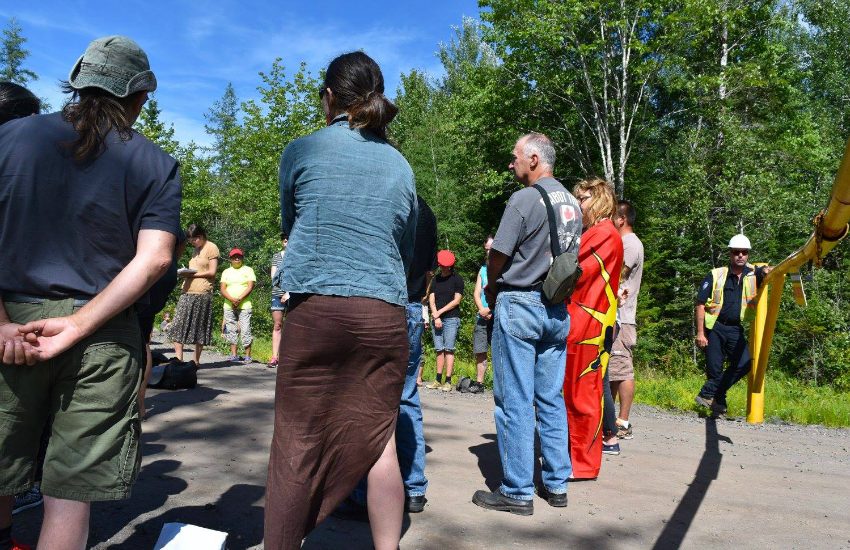KJIPUKTUK (Halifax) – Lots has been written about the protracted battles on the planned Alton Gas discharge of huge amounts of salt brine into the Shubenacadie River.
However, the Alton Gas salt caverns have mostly managed to escape scrutiny from the regulators. News that two of the four drilled wells are unusable should cause some alarm bells to go off. There are reasons to question whether any regulation and oversight has occurred at all on potential environmental effects at the salt cavern site.

The 2007 environmental assessment (EA) for the proposed project dealt mostly with potential effects on fish and fish habitat at the Shubenacadie River, and to a lesser extent with species along the water and brine pipeline route. There was considerable follow-up and expansion on the scrutiny by the federal Department of Fisheries and Oceans, although many questions remain.
But all of that is on the operation of the river discharge facility or on construction of all parts of the operation. There is nothing covering the operation of the salt caverns. And unlike in the case of the river discharge facility, there was no Supplemental Information about the salt caverns requested by the Environment Department.
However, even a cursory reading about underground gas storage reveals risks of both chronic methane leakages or even catastrophic leaks and explosions. Nonetheless, the entire regulatory process to date has been silent about potential methane leakage from the proposed Alton Gas Storage caverns.
Utility Board incorrectly assumed environmental oversight regulated by Environment Department
Constructing a storage cavern in an underground salt bed begins with a well drilled into the bed in order to inject water and so gradually form a cavern. Alton Gas drilled four such wells at the cavern site.
One well failed completely. Recently the company backed into admitting that another well cannot be developed into a cavern. The reason given is that “the location is not good.” What that really means is that analysis of the drill core samples showed that the structure of the salt is not good enough to ensure the integrity of a cavern.
The structural integrity of the salt in a bed is crucial to the viability and safety of storing pressurized natural gas in a cavern. The principle of sealing a cavern against leaks is based on the strength of bedded pure salt. But an underground salt bed does not contain only salt. Salt beds are veined with other material deposited when an ancient inland sea evaporated.
There are no perfectly uniform salt beds. The integrity of a salt cavern depends on whether the salt bed is uniform enough. Evidence for that comes from the drill core samples. Despite the strained attempts by Alton Gas to spin a different story, the reason why Alton Gas has eliminated the third well for development into a storage cavern are these poor drill core samples.
Questions about the integrity of the proposed salt caverns were central to the scrutiny by the Nova Scotia Utility and Review Board (UARB) for the Alton Gas application to construct up to 18 salt caverns. The Board approval in 2013 included monitoring programs for testing the caverns as they are developed.
It is not the Board’s mandate to scrutinize potential environmental effects of proposed projects, but in the course of its overall due diligence the UARB wanted to see evidence that these concerns were being addressed. During the review process the Board’s technical representative asked of Alton Gas:
The Applicant states that it “will comply to applicable guidelines” with respect to environmental issues; however, limited detail is provided. Some additional information with respect to the existing environmental permits would assist in the CA’s review. Therefore, the CA requests documentation of the referenced Environmental Assessment (EA) Approval
The Alton Gas response, by its consultants:
The specific information the Certifying Authority requested is public; however, the EA referred to reaches far beyond the scope of this Application. We direct the Certifying Authority to the online information filed with Nova Scotia Environment
What the consultants neglected to mention was that there was no information about environmental effects of the salt caverns in any of the documents that Alton Gas refers to. Not surprisingly, the UARB was assured by the claim of environmental oversight and regulation. And none of the pages of requirements in the Board’s approval of the salt caverns addresses environmental effects or mitigation in any way.
Has there ever been any oversight of environmental effects at the salt cavern site?
It is not only Alton Gas that used the mere fact an environmental assessment happened as evidence that environmental effects are being adequately regulated. Environment Minister Margaret Miller constantly points to the “extensive” environmental review process of the Alton Gas project since 2007.
An environmental assessment is only the initial platform for regulating a project. The Shubenacadie River discharge end of the proposed project had a substantial amount of review and follow-up after the EA, which ended with the Industrial Approval that all facilities need to operate. There is a huge controversy about the lack of consultation and the adequacy of the science and oversight that went into the process, but there is no question that for the river discharge facility the regulatory steps of the process did happen.
However, the salt cavern site is barely mentioned in the environmental assessment, there was no follow-up to the EA, there is no Industrial Approval for the site even as it is poised to begin operation, and the utility regulator that permitted the work at the site is on record as believing that regulation of environmental effects has been taken care of by the provincial government.



